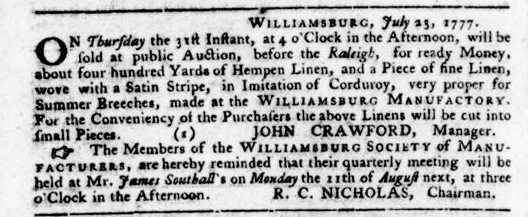In 1774, delegates to the first Continental Congress signed an Association restricting the import of goods from England and encouraging domestic production. Article Eight read:
We will, in our several stations, encourage frugality, œconomy, and industry, and promote agriculture, arts and the manufactures of this country, especially that of wool; and will discountenance and discourage every species of extravagance and dissipation, especially all horse racing, and all kinds of gaming, cock fighting, exhibitions of shews, plays, and other expensive diversions and entertainments; and on the death of any relation or friend, none of us, or any of our families will go into any further mourning-dress, than a black crepe or ribbon on the arm or hat, for gentlemen, and a black ribbon and necklace for ladies, and we will discontinue the giving of gloves and scarves at funerals.
Communities across the thirteen colonies, including the south, began producing a wide variety of textiles. Once the war broke out in April 1775, the demand for textiles increased further. A group of gentlemen in Williamsburg, Virginia created the Williamsburg Manufactory, a weaving facility located just outside the city for war production. Newspaper articles advertise some of the textiles produced there which included “a piece of fine linen, with a satin stripe, in imitation of Corduroy, very proper for summer breeches.” While no samples of this fabric survive, the managers and weavers saw it proper to produce light weight fabrics for the summer.
